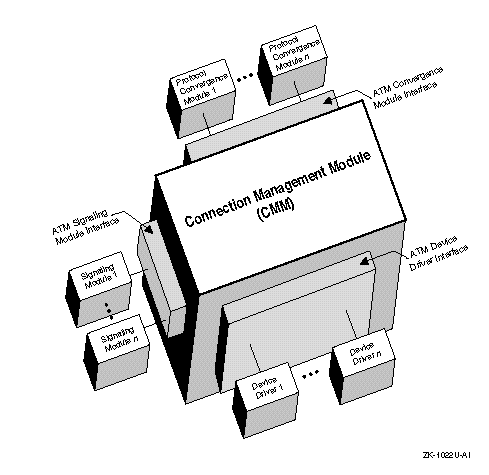Asynchronous Transfer Mode (ATM) networks promise to become the dominant network interconnect because they provide the following capabilities:
Presently, interest in implementing ATM networks, particularly in the local area, comes from applications that need the high speed and the low latency (switched, full duplex network infrastructure) that ATM networks provide.
Caution
Because of changes in the Digital UNIX kernel, ATM code compiled under previous versions of the operating system must be recompiled. In addition, because of changes to the ATM interfaces, you should verify and change, if necessary, the correct number and type of arguments in ATM function calls before recompiling.
The Digital UNIX ATM subsystem is a separately configurable kernel subsystem with the following characteristics:
The Digital UNIX ATM subsystem consists of the following parts:
This module handles all communications between the various elements of the ATM subsystem as well as managing all virtual circuits (VCs) and communications with protocol stacks that use ATM.
These device drivers handle the hardware-specific details for controlling specific adapters.
These modules implement specific protocols for communicating connection management information between the end system and the switch. In this implementation, UNI 3.0 is the default signaling protocol module that the Digital UNIX ATM subsystem uses.
Figure 1-1 illustrates the ATM subsystem.

The Digital UNIX ATM subsystem supports any number of ATM device drivers and signaling protocol modules as long as the actions of these modules do not interfere with each other. ATM modules should communicate only with the CMM as the CMM coordinates all communications between ATM modules. ATM modules should never bypass the CMM and communicate with each other directly.
The three elements of the ATM subsystem provide only raw ATM services. They do not implement any specific protocol for carrying data over the ATM network. That is, the ATM subsystem is entirely protocol independent. If a specific protocol wants to use the ATM network to transport data, the protocol must provide an interface into the ATM subsystem.
The programs that provide the interface between the ATM subsystem and specific protocols are called convergence modules. These modules, using the ATM subsystem interface KPI, control the creation and use of ATM VCs in a manner appropriate for the protocol. Since different protocols have different requirements, the ATM subsystem leaves the adaptation of the protocol to use ATM entirely up to the protocol implementor. The ATM subsystem does not provide any protocol-specific services.
The CMM is the central module in the Digital UNIX ATM subsystem and has the following duties:
The CMM provides the following interfaces:
ATM adapter device drivers use this interface to access the ATM subsystem. See Chapter 4 for more information.
Modules that implement ATM signaling protocols use this interface. This interface allows multiple signaling modules to provide services to protocol stacks on a per-VC basis, as long the signaling modules do not conflict on the ATM network. See Chapter 5 for more information.
Kernel protocol stacks use this external interface to the ATM subsystem to gain access to the ATM subsystem services. See Chapter 6 for more information.
These interfaces are registration-type interfaces. Each makes calls to the CMM to inform the CMM of its presence. The CMM places no limit on the number of each type of module that may register, the total number being limited only by system resources.
Before you communicate on the ATM network, you must install the Digital DGLTA or DGLPB ATM adapter and configure the ATM software. See the ATMworks 750 Installation and Service manual for information on installing the DGLTA ATM adapter and Chapter 2 for information on configuring the ATM software. .